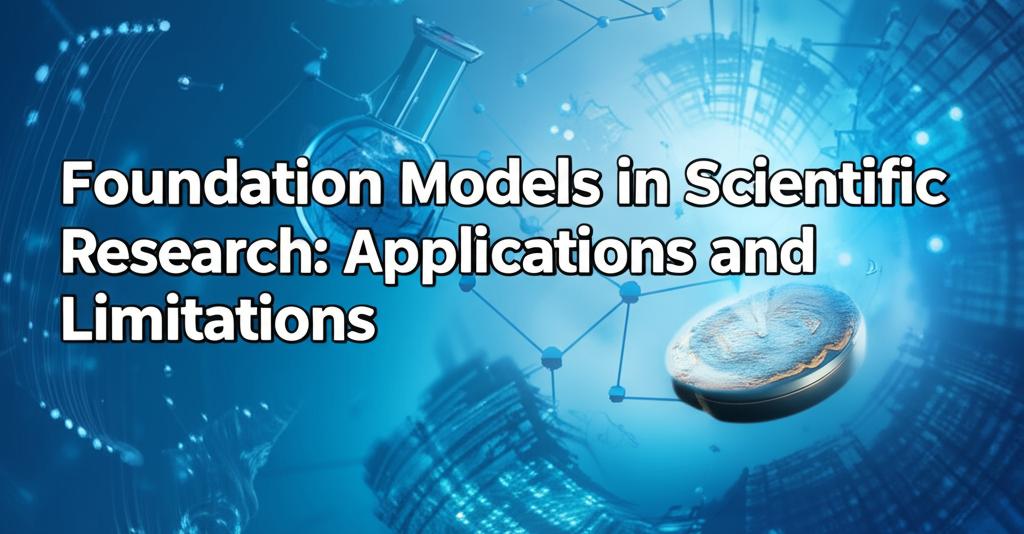Foundation models, which are large-scale machine learning models trained on vast and diverse datasets, are ushering in a new era in scientific research. These models, such as GPT-3, BERT, and DALL-E, are not designed for a single specific task but can be adapted to a wide array of applications, making them incredibly versatile tools for discovery and innovation.
Applications in Scientific Research:Foundation models are demonstrating significant promise across various scientific disciplines:
- Accelerating Discovery: By identifying patterns and making predictions from massive datasets, foundation models can significantly speed up the scientific discovery process. They can help researchers formulate hypotheses, design experiments, and analyze complex data in a fraction of the time traditionally required.
- Materials Science: AI foundation models are being developed to accelerate the design and discovery of new materials with desired properties. This can involve predicting molecular combinations or generating novel material structures, potentially revolutionizing fields like energy, electronics, and health. For example, Microsoft Research's MatterGen is a generative model capable of designing entirely new materials.
- Healthcare and Biomedicine: In healthcare, these models are being applied to tasks ranging from analyzing medical images with greater precision (like the "Human Radiome Project" for CT and MRI scans) to drug discovery and understanding cellular interactions ("VirtualCell" project). They can assist in clinical pathology, patient stratification, and predicting protein functions.
- Climate Science and Environmental Studies: Foundation models are being used to improve weather forecasting, such as Microsoft's Aurora weather model. They can also help analyze complex environmental data to better understand climate change and its impacts.
- Genomics and Life Sciences: Models like xLSTM-based foundation models are being tailored for sequence data in DNA and proteins, enhancing efficiency in areas like drug discovery and metagenomic modeling for tracking pandemics.
- Astronomy and Physics: Foundation models are contributing to research in these fields by analyzing vast astronomical datasets and modeling complex physical phenomena.
- Multimodal Data Analysis: These models can process and find connections across different types of data (text, images, code, sensor data), which is increasingly important in modern science where research often involves diverse data sources.
The general approach involves two main stages:
- Pre-training: The model is trained on broad, unlabelled scientific data to learn general patterns, relationships, and a foundational knowledge base relevant to scientific domains.
- Fine-tuning (Adaptation): The pre-trained model is then adapted for specific scientific tasks using smaller, domain-specific datasets. This process is typically more efficient than training a model from scratch for each new task.
Despite their transformative potential, foundation models also present several limitations and challenges in the scientific context:
- Data Quality and Availability: The performance of foundation models heavily relies on the quality and quantity of training data. Access to high-quality, specialized, and unbiased scientific datasets can be a significant hurdle. Many existing models are trained on public internet data, which may lack industry-specific or nuanced scientific knowledge.
- Bias: If the training data contains biases, the foundation model can perpetuate and even amplify these biases in its outputs and predictions. This is a critical concern in scientific research where objectivity is paramount.
- Interpretability and Explainability (Black Box Problem): Understanding how these complex models arrive at their conclusions can be difficult. This lack of transparency can be a barrier to trust and adoption in scientific fields where understanding the underlying mechanisms is crucial.
- Computational Resources and Cost: Training and fine-tuning large foundation models require immense computational power and energy, leading to concerns about cost, accessibility for smaller research groups, and environmental impact.
- Hallucinations and Accuracy: Foundation models can sometimes generate plausible-sounding but incorrect or nonsensical information (often referred to as "hallucinations"). Ensuring scientific accuracy and validity is a major challenge, especially in preclinical R&D and other critical applications.
- Domain Adaptation: While adaptable, effectively fine-tuning a general foundation model for highly specialized scientific domains or niche applications can still be challenging and require substantial domain-specific data and expertise.
- Security and Privacy: When dealing with sensitive scientific data, such as patient information in medical research, ensuring data privacy and security when using foundation models is a critical concern.
- Ethical Considerations: The development and deployment of foundation models raise ethical questions related to data ownership, intellectual property (especially if trained on copyrighted material), potential misuse, and the impact on the scientific workforce. Ensuring fairness, accountability, and responsible AI adoption is crucial.
- Integration and Maintenance: Integrating these models into existing scientific workflows and maintaining them over time can be complex.
- Benchmarking and Evaluation: Developing robust methods to evaluate the true capabilities, strengths, and weaknesses of foundation models in scientific contexts is an ongoing research area. Benchmarks can quickly become obsolete as models evolve.
- Homogenization: The widespread adoption of a few dominant foundation models could lead to a homogenization of research approaches, potentially stifling diverse methodologies and inadvertently propagating flaws inherent in the base models.
Addressing these limitations requires concerted efforts. This includes emphasizing open science principles to promote transparency, reproducibility, and shared access to datasets and models. Collaborative, interdisciplinary efforts involving researchers, academic institutions, government bodies, and technology companies are essential for developing more effective, robust, and ethically sound foundation models for scientific research. Furthermore, developing specialized "Scientific Foundation Models" (SciFMs) tailored to specific scientific domains is a growing area of focus. Regulatory frameworks and ethical guidelines also need to co-evolve with the technology to ensure responsible innovation.
In conclusion, foundation models are powerful tools with the potential to dramatically accelerate scientific research and innovation. However, realizing this potential requires a clear understanding of their current capabilities and limitations, alongside a commitment to addressing the associated technical, ethical, and societal challenges.

